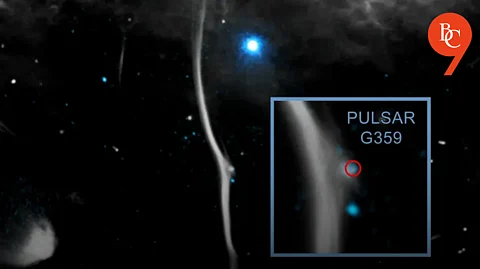

At the heart of this discovery is G359.13142-0.20005, or G359.13 for short, a long, linear structure near the center of the Milky Way. Often called a “cosmic bone” or “the Snake” due to its shape and density, G359.13 stretches an astonishing 230 light-years-longer than the distance between Earth and more than 800 nearby stars. Located about 26,000 light-years from Earth, it is one of the brightest and longest features of its kind in the galaxy.
These cosmic bones are immense filaments observed in radio waves, threaded by magnetic fields running parallel to their length. The radio emissions are produced by energized particles spiraling along these magnetic fields, creating the striking, bone-like appearance.
NASA’s Chandra X-ray Observatory, in combination with South Africa’s MeerKAT radio array and the National Science Foundation’s Very Large Array, captured detailed images of G359.13. Upon close examination, astronomers identified a distinct break-a fracture-in what was otherwise a continuous structure.
At the exact location of this fracture, both X-ray and radio sources were detected. Further analysis revealed that the culprit is likely a pulsar-a highly magnetized, rapidly spinning neutron star left behind after a massive star’s explosive death. Pulsars are among the densest objects in the universe and often receive a powerful “kick” during their formation, propelling them through space at incredible speeds.
Researchers believe the fracture in G359.13 was caused when a pulsar, hurtling through the galaxy at a speed between one and two million miles per hour, smashed directly into the cosmic bone. This collision not only disrupted the structure, creating a visible break, but also distorted the magnetic fields and warped the radio emissions along the filament.
The X-ray and radio data at the fracture site suggest that the pulsar’s passage accelerated electrons and positrons (the antimatter counterparts of electrons) to high energies, further altering the cosmic bone’s properties.
NASA’s revelation of a fracture in the Milky Way’s massive cosmic bone, caused by a pulsar collision, underscores the dynamic and sometimes violent nature of our galaxy. As telescopes like Chandra and MeerKAT continue to probe the cosmos, more secrets about the forces shaping our universe are sure to emerge-reminding us that even in the vastness of space, dramatic events can leave their mark for millennia.
